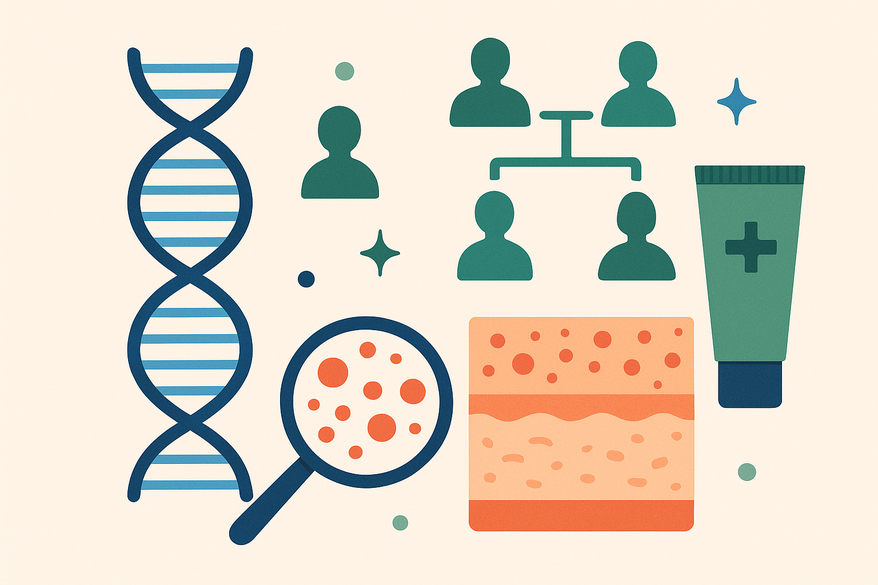Understanding Family History and Rash Development: How Genetics Influence Skin Rashes
Explore how genetics, family history, and rash development are linked to anticipate, prevent, and treat skin rashes effectively. Learn prevention strategies.

8 min read
Key Takeaways
- Family history is a powerful predictor of skin rash risk and guides early intervention.
- Genetic factors like FLG and CARD11 mutations raise atopic dermatitis and eczema risks.
- Common hereditary conditions include eczema, psoriasis, FAMM syndrome, and ichthyosis.
- Environmental triggers—allergens, stress, infections—interact with genes to spark rashes.
- Prevention and management hinge on barrier repair, trigger avoidance, and tailored treatment plans.
Table of Contents
- Defining Family History and Rash Development
- Genetic Predisposition and Hereditary Factors
- Common Hereditary Skin Conditions
- Environmental Triggers vs Genetic Factors
- Diagnosing and Managing Rashes
- Preventative Strategies and Lifestyle Tips
- Conclusion
Defining Family History and Rash Development
Family history refers to the documented record of health conditions among biological relatives, used by clinicians to assess genetic risk.
Rash development describes the emergence of abnormal skin changes—redness, bumps, scaling, or inflammation. When rashes are genetic, they often recur within families.
Key Definitions
- Family history: A record of illnesses in blood relatives to predict inherited risks.
- Rash development: Skin responses like itching and inflammation triggered by genes or environment.
Clinical Note: In practice, mapping a three-generation family tree often uncovers patterns—such as widespread eczema—that guide genetic counseling and early intervention.
Genetic Predisposition and Hereditary Factors
Genes can set the stage for rash development long before symptoms appear. Researchers have identified key risk genes and inheritance patterns (see our in-depth guide).
Risk Genes and Inheritance
- FLG gene (filaggrin): Mutations weaken the skin barrier, increasing atopic dermatitis risk.
- CARD11 gene: Variants alter immune signaling, linked to eczema flares.
- Autosomal dominant: One mutated copy from a parent is enough to pass on risk.
Probability of Inheritance
- One affected parent → ~50% chance a child develops eczema, asthma, or hay fever.
- Both parents affected → risk increases to ~75%.
- ~70% of atopic dermatitis patients report a family history of atopy.
Expert Insight: A study at Rady Children’s Hospital found early emollient use can reduce eczema incidence by up to 30% in high-risk infants when parental atopy is documented.
Common Hereditary Skin Conditions
Inherited disorders often present with rashes that recur in families. Recognizing them enables early diagnosis and targeted care (learn more about hereditary rashes risk factors).
- Atopic Dermatitis (Eczema)
Chronic, itchy inflammation linked to FLG mutations. Familial recurrence ~70%. - Psoriasis
Autoimmune rash causing red, scaly plaques. ~1/3 of patients have a close relative affected; HLA-Cw6 is a key marker. - FAMM Syndrome
Dysplastic moles across generations with up to 100× melanoma risk. Requires regular exams and counseling. - Ichthyosis
Inherited dry, scaly “fish-scale” rash; most common form is autosomal recessive.
Environmental Triggers vs Genetic Factors
Genetic predisposition alone does not guarantee a rash. External factors often dictate whether and how severely a rash appears.
Common Environmental Triggers
- Allergens: pollen, pet dander, dust mites
- Infections: strep throat, viral illnesses
- Stress: physical or emotional (stress-related triggers)
- Climate: extreme cold, heat, low humidity
Gene–Environment Interaction
- FLG mutations plus harsh detergents can break down the skin barrier.
- Stress hormones may exacerbate immune responses in atopic families.
- Low humidity can tip genetically susceptible individuals into eczema.
Clinical Tip: A “rash diary” noting weather, products, diet, and stress often reveals triggers within weeks.
Diagnosing and Managing Rashes
Accurate diagnosis and a tailored plan depend on family history. Digital tools like Rash Detector let patients upload rash images for preliminary AI analysis.

Diagnosis Steps
- Gather a detailed dermatological history, including a three-generation pedigree.
- Perform a clinical skin exam: note type, distribution, and chronicity.
- Consider genetic testing for syndromic or rare hereditary conditions.
Management Strategies
- Avoid identified triggers using patient interviews and rash diaries.
- Daily barrier repair with emollients and fragrance-free cleansers.
- Topical anti-inflammatories: steroids or calcineurin inhibitors as prescribed.
- Phototherapy or systemic agents for severe cases under specialist supervision.
- Refer to genetics or dermatology specialists when multiple syndromes are suspected.
Patient Example: A 10-year-old with parental eczema switched to a ceramide-based moisturizer and pH-balanced soap; flares dropped from monthly to twice yearly.
Preventative Strategies and Lifestyle Tips
Proactive habits can reduce flare frequency and severity for those with genetic predisposition.
- Maintain a gentle, consistent skin-care routine with fragrance-free products.
- Avoid irritants: wool, harsh detergents, certain fragrances.
- Regulate environment: use humidifiers, wear breathable fabrics.
- Manage stress: meditation, exercise, adequate sleep.
- Seek prompt medical evaluation at the first sign of a rash.
FAQ
- How important is family history in diagnosing skin rashes?
- Family history helps clinicians predict inherited risks, tailor early prevention, and decide on genetic testing when needed.
- Can environmental changes prevent genetically linked rashes?
- Yes. Minimizing triggers—like allergens, stress, and harsh climates—can significantly reduce flare frequency and severity.
- When should I consult a specialist?
- See a dermatologist or genetic counselor if rashes are severe, chronic, involve multiple family members, or if rare syndromes are suspected.





